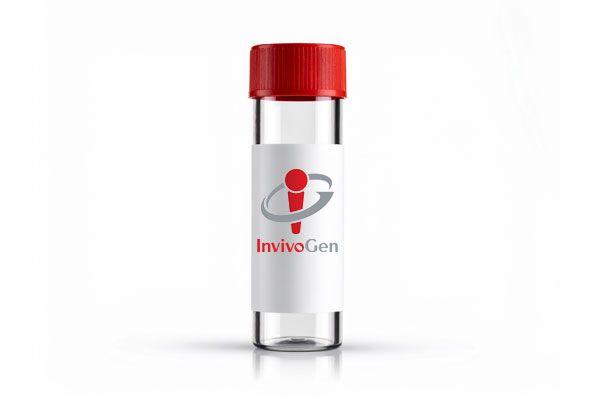HEK-Blue™ hACE2-TMPRSS2 Cells
-
Cat.code:
hkb-hace2tpsa
- Documents
ABOUT
HEK293 NF-κB-reporter cells expressing the SARS-CoV-2 receptors
InvivoGen offers human embryonic kidney 293 (HEK-293)-derived cell lines, specifically designed for COVID-19 studies:
— HEK-Blue™ hACE2-TMPRSS2 cells
— HEK-Blue™ hACE2 cells
These cells have been engineered to stably overexpress the host SARS-CoV-2 receptors, human (h)ACE2, and TMPRSS2 [1]. They were generated from HEK‑Blue™ Null1‑v cells, which express an NF-κB inducible SEAP (secreted embryonic alkaline phosphatase) reporter gene.
Sensitive to SARS-CoV-2
SARS-CoV-2, the causative agent of coronavirus disease-19 (COVID-19), gains entry into host cells through the interaction of the viral Spike protein with the host ACE2 and TMPRSS2 receptors [1]. HEK293-derived cells are poorly permissive to infection by SARS-CoV-2 or Spike pseudotyped lentiviral particles. Therefore, to increase their permissivity HEK-Blue™ Null1-v cells have been stably transfected with ACE2 only, or ACE2 and TMPRSS2. In contrast to HEK-Blue™ Null1-v cells, HEK-Blue™ hACE2(‑TMPRSS2) cells are sensitive to Spike pseudotyped lentiviral particles. Notably, the addition of TMPRSS2 increases the cell line’s infectivity.
For studying Spike-ACE2-dependent cell fusion
These HEK-293-derived SARS-COV-2 permissive reporter cells can be used as ‘acceptor’ cells in InvivoGen’s SARS-CoV-2 Spike-ACE2 dependent cell fusion assay. This relies on the transfer of the TLR/IL-1 adaptor molecule, MyD88, from a 'donor cell line' (293-hMyD88 transfected with a Spike expression plasmid) to an 'acceptor cell line' expressing an NF-κB-SEAP-inducible reporter gene. Cell fusion is readily assessable in the co-culture supernatant using the SEAP detection reagent, QUANTI‑Blue™ Solution. Unlike infection by pseudotyped particles, the presence of TMPRSS2 does not have an effect on cell fusion in this assay.
Key features
- Verified overexpression of human ACE2 and TMPRSS2 genes
- Permissive and sensitive to SARS-COV-2 Spike pseudotyped lentiviral particles
- Functionally tested in InvivoGen’s cell fusion assay with SARS-CoV-2 Spike-expressing hMyD88 cells.
- Readily assessable NF-κB-dependent SEAP reporter activity
Applications
- Screening inhibitors of Spike-binding and/or its host receptors (i.e. ACE2 and TMPRSS2).
- Studying the efficacy of the vaccines and/or current therapeutics (e.g. mAbs) against the emerging variants by infection studies with pseudotyped particles or cell fusion assays.
InvivoGen has also generated:
➔ HEK-Lucia™ hACE2 and HEK-Lucia™ hACE2-TMPRSS2 cells featuring an NF-KB-inducible Lucia luciferase reporter for a larger detection range than the colorimetric SEAP assays.
➔ HEK-hACE2 and HEK-hACE2-TMPRSS2 cells with no reporter activity for infection, pseudoparticle transduction, or qualitative fusion assays.
These cells have been used to compare the efficiency of SARS-CoV2 Spike variant-mediated cellular infection and fusion. See data
![]() Learn more about SARS-CoV-2 infection and potential therapeutics
Learn more about SARS-CoV-2 infection and potential therapeutics
References
1. Hoffmann M. et al., 2020. SARS-CoV-2 cell entry depends on ACE2 and TMPRSS2 and is blocked by a clinically proven protease inhibitor. Cell. 181:1-16.
2. Zhou P. et al., 2020. A pneumonia outbreak associated with a new coronavirus of probable bat origin. Nature. 579(7798):270-273.
3. Walls A.C. et al., 2020. Structure, function, and antigenicity of the SARS-CoV-2 spike glycoprotein. Cell. 181(2):281-292.e6.
Disclaimer: These cells are for internal research use only and are covered by a Limited Use License (See Terms and Conditions). Additional rights may be available.
SPECIFICATIONS
Specifications
Human
Cell fusion assays, infection studies with pseudotyped particles
Complete DMEM (see TDS)
Verified using Plasmotest™
Each lot is functionally tested and validated.
CONTENTS
Contents
-
Product:HEK-Blue™ hACE2-TMPRSS2 Cells
-
Cat code:hkb-hace2tpsa
-
Quantity:3-7 x 10^6 cells
- 1 ml of Puromycin (10 mg/ml)
- 1 ml of Zeocin® (100 mg/ml)
- 1 ml of Normocin™ (50 mg/ml). Normocin™ is a formulation of three antibiotics active against mycoplasmas, bacteria, and fungi.
- 1 ml of QB reagent and 1 ml of QB buffer (sufficient to prepare 100 ml of QUANTI-Blue™ Solution, a SEAP detection reagent)
Shipping & Storage
- Shipping method: Dry ice
- Liquid nitrogen vapor
Storage:
Details
ACE2 and TMPRSS2 Background
ACE2 (angiotensin I-converting enzyme-2) and TMPRSS2 (transmembrane protease serine 2) play a critical role in the pathogenesis of COVID-19 by allowing viral entry into target cells. ACE2 and TMPRSS2 are cell-surface proteins that both interact with the virus Spike (S) protein [1-3]. ACE2 is mandatory for the binding of SARS-CoV-2 at the cell surface through its interaction with the Spike receptor-binding domain (RBD) [4]. Following this, TMPRSS2 cleaves the S protein into two functional subunits (S1 and S2), allowing virus-host membrane fusion, and the release of viral contents (e.g. RNA) into the cytosol [3-5]. Another protease, the Cathepsin L, also mediates cleavage of the S protein but it acts in the endosomes. Camostat is a clinically proven inhibitor of TMPRSS2 and has been shown to inhibit SARS-CoV-2-S pseudotyped viral particles entry into primary human lung cells in a dose-dependent manner [2]. This observation demonstrates the critical implication of TMPRSS2 in SARS-CoV-2 infection and spread. Moreover, in lung cells that fail to express robust levels of Cathepsin L, the virus entry depends on a furin-mediated pre-cleavage of the S protein at the S1/S2 site, before subsequent TMPRSS2-mediated cleavage at the S2' site [6]. Notably, TMPRSS2 may not be needed for infection of HEK293 cells by SARS-CoV-2 spike-pseudotyped lentiviral particles, however, it does increase their sensitivity to infection [in-house data].
References
1. Chen H. et al., 2020. SARS-CoV-2 activated lung epithelia cell proinflammatory signaling and leads to immune dysregulation in COVID-19 patients by single-cell sequencing. medRxiv: DOI 10.1101/2020.05.08.20096024.
2. Hoffmann M. et al., 2020. SARS-CoV-2 cell entry depends on ACE2 and TMPRSS2 and is blocked by a clinically proven protease inhibitor. Cell. 181:1-16.
3. Matsuyama S. et al., 2020. Enhanced isolation of SARS-CoV-2 by TMPRSS2-expressing cells. PNAS. 117(13):7001-7003.
4. Zhou P. et al., 2020. A pneumonia outbreak associated with a new coronavirus of probable bat origin. Nature. 579(7798):270-273.
5. Walls A.C. et al., 2020. Structure, function, and antigenicity of the SARS-CoV-2 spike glycoprotein. Cell. 181(2):281-292.e6.
6. Hoffman M. et al., 2020. A multibasic cleavage site in the Spike protein of SARS-CoV-2 is essential for infection of human lung cells. Molecular Cell. 78:;1-6.
DOCUMENTS
Documents
Technical Data Sheet
Validation Data Sheet
Safety Data Sheet
Certificate of analysis
Need a CoA ?









